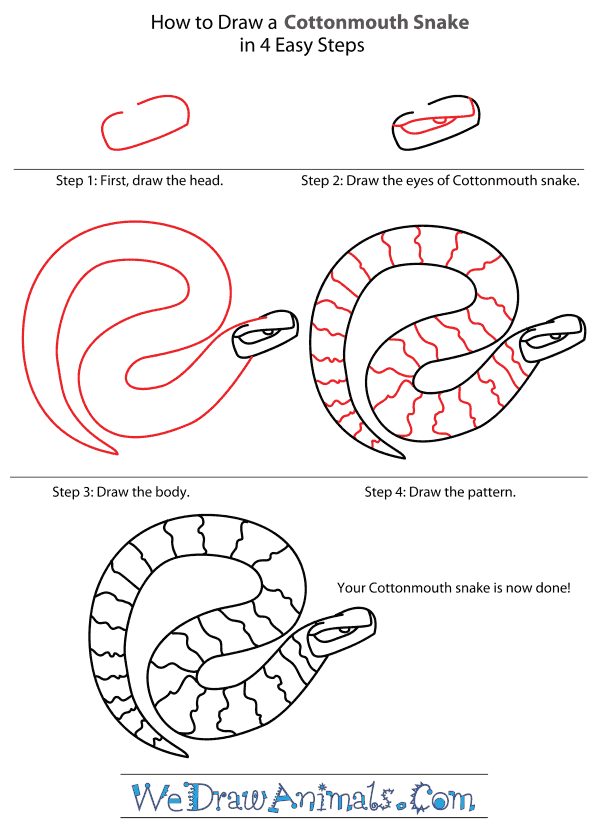In this quick tutorial you'll learn how to draw a Cottonmouth in 4 easy steps - great for kids and novice artists.
The images above represent how your finished drawing is going to look and the steps involved.
Below are the individual steps - you can click on each one for a High Resolution printable PDF version.
At the bottom you can read some interesting facts about the Cottonmouth.
Make sure you also check out any of the hundreds of drawing tutorials grouped by category.
How to Draw a Cottonmouth - Step-by-Step Tutorial
Step 1: The first step in drawing your cottonmouth snake is to draw its head. To create the head draw an oval with one side flat and an opening on the other side.
Step 2: The next step will be to draw the cottonmouth's eye. To do this, draw two straight lines that come to a point for the top of the eye as shown above. Next create an elongated triangle for the main portion of the eye. In side that draw a small circle.
Step 3: Now you will draw the snake's body. For the body you will draw two parallel curving lines that move in an S shape and come together at a point for the tail.
Step 4: For the final step you will need to add the pattern onto the snake's body. This can be done by adding horizontal jagged lines evenly spaced along the body from the head to the tail. You have now successfully drawn a cottonmouth snake. Cottonmouths are mostly non aggressive snakes that can reach up to 6 feet long. When threatened they will often resort to defensive tactics or attempt to escape. This type of snake likes water and is very rarely found more than one mile from a source of water.
Interesting Facts about the COTTONMOUTH
The Cottonmouth is a member of the reptile family and the scientific term for them is Agkistrodon piscivorus. Another name for this animal is the Water Moccasin. This venomous snake is a species of pit viper, named for the small holes on its face which detect heat from warm animals.
Did you know?
- The animal was first documented in 1789.
- There are up to 9 scales on their upper lip.
- These are up to 12 scales on their lower lip.
- There are up to 27 rows of scales on their back.
- They can grow to be up to over 6 feet long.
- The snake has been found to be more than 1 mile from a water source.
- These are mostly not aggressive, as about 51 percent of them will attempt escape when threatened.
- They will resort to defensive tactics up to 78 percent of the time, instead of attacking.
These animals are black with some yellow stripes. They are found in the southeastern region of the United States and can deliver a bite that is deadly to humans. There are not many of these creatures, but they‘re the least concern for a possibility of extinction.





